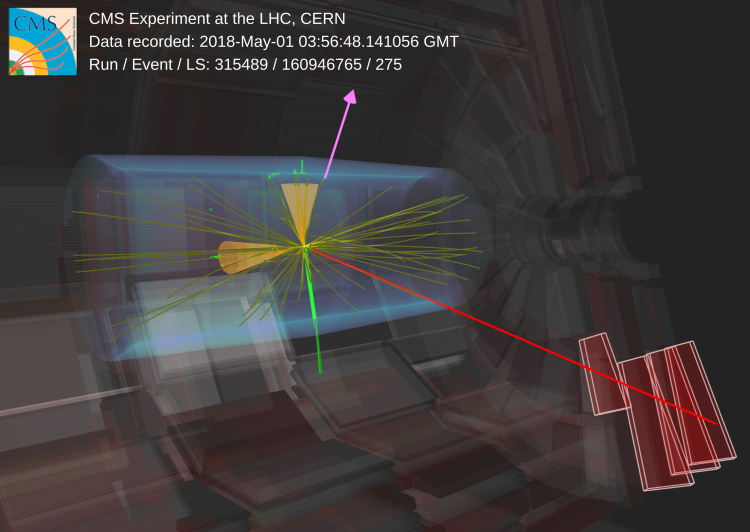
Event display of the excess of top-quark pairs. (Image: CMS collaboration/CERN)
The CMS collaboration at CERN has observed an unexpected feature in data produced by the Large Hadron Collider (LHC), which could point to the existence of the smallest composite particle yet observed. The result, reported at the Rencontres de Moriond conference in the Italian Alps this week, suggests that top quarks - the heaviest and shortest lived of all the elementary particles - can momentarily pair up with their antimatter counterparts to produce an object called toponium. Other explanations cannot be ruled out, however, as the existence of toponium was thought too difficult to verify at the LHC, and the result will need to be further scrutinised by CMS's sister experiment, ATLAS.
High-energy collisions between protons at the LHC routinely produce top quark-antiquark pairs (tt-bar). Measuring the probability, or cross section, of tt-bar production is both an important test of the Standard Model of particle physics and a powerful way to search for the existence of new particles that are not described by the 50-year-old theory. Many of the open questions in particle physics, such as the nature of dark matter, motivate the search for new particles that may be too heavy to have been produced in experiments so far.
CMS researchers were analysing a large sample of tt-bar production data collected in 2016-2018 to search for new types of Higgs bosons when they spotted something unusual. Additional Higgs-like particles are predicted in many extensions of the Standard Model. If they exist, such particles are expected to interact most strongly with the singularly massive top quark, which weighs in at 184 times the mass of the proton. And if they are massive enough to decay into a top quark-antiquark pair, this should dominate the way they decay inside detectors, with the two massive quarks splintering into "jets" of particles.
Observing more top-antitop pairs than expected is therefore often considered to be a smoking gun for the presence of additional Higgs-like bosons. The CMS data showed just such a surplus. Intriguingly, however, the collaboration observed the excess top-quark pairs at the minimum energy required to produce a pair of top quarks. This led the team to consider an alternative hypothesis long considered difficult to detect: a short-lived union of a top quark and a top antiquark, or toponium.
While tt-bar pairs do not form stable bound states, calculations in quantum chromodynamics - which describes how the strong nuclear force binds quarks into hadrons - predict bound-state enhancements at the tt-bar production threshold. Though other explanations - including an elementary boson such as appears in models with additional Higgs bosons - cannot be ruled out, the cross section that CMS obtains for a simplified toponium-production hypothesis is 8.8 picobarns with an uncertainty of about 15%. This passes the "five sigma" level of certainty required to claim an observation in particle physics, and makes it extremely unlikely that the excess is just a statistical fluctuation.
If the result is confirmed, toponium would be the final example of quarkonium - a term for unstable quark-antiquark states formed from pairings of the heavier charm, bottom and perhaps top quarks. Charmonium (charm-anticharm) was discovered simultaneously at Stanford National Accelerator Laboratory in California and Brookhaven National Laboratory in New York in the November Revolution in particle physics of 1974. Bottomonium (bottom-antibottom) was discovered at Fermi National Accelerator Laboratory in Illinois in 1977. Charmonium and bottomonium are approximately 0.6 and 0.4 femtometres in size respectively, where one femtometre is a millionth of a nanometre. Bottomonium is thought to be the smallest hadron yet discovered. Given its larger mass, toponium is expected to be far smaller - qualifying it as the smallest known hadron.
For a long time, it was thought that toponium bound states were unlikely to be detected in hadron-hadron collisions. The top quark decays into a bottom quark and a W boson in the time it takes light to travel just 0.1 femtometre - a fraction of the size of the particle itself. Toponium would therefore be unique among quarkonia in that its decay would be triggered by the spontaneous disintegration of one of its constituent quarks rather than by the mutual annihilation of its matter and antimatter components.
CMS and ATLAS are now working closely to study the effect, which remains an open scientific question.






